Table of Contents
- Introduction
- Editor’s Choice
- Global Employee Wellbeing Statistics
- Wellbeing Priorities of Employee Statistics
- Employee Sense of Wellbeing from Their Organization Worldwide Statistics
- Perception of Organizational Wellbeing Support Among Employee Statistics
- Employee Positive Perceptions of Their Wellbeing Statistics
- Perception of Employee on Physical and Mental Wellbeing Statistics
- Impact of Jobs On Mental Health According to Employee Wellbeing Statistics
- Positive Perceptions of Employee Wellbeing Statistics
- Satisfaction of Employee Wellbeing with Their Financial Situation Statistics
- Employees’ Sense of Appreciation at Their Organization
- Employees’ Sense of Success from Their Organization Worldwide
- Job Satisfaction Rates of Employees – By Education Level
- Attitudes About Work Among Employees
- Impact of Company Culture and Environment On Employee Wellbeing Statistics
- Employee Wellbeing Initiatives Statistics
- Impact of COVID-19
- Suggestions and Solutions to Support Employee Wellbeing Statistics
- Recent Developments
- Conclusion
- FAQs
Introduction
Employee Wellbeing Statistics: Employee well-being is crucial for organizational success, encompassing physical, mental, and emotional health.
It begins with providing a safe, ergonomic workplace and promoting regular breaks and physical activity. Supporting mental health involves reducing stigma, offering counseling, and promoting work-life balance.
A positive workplace culture fosters well-being through open communication, recognition, and fair policies. Professional development opportunities and competitive benefits further enhance job satisfaction.
Leadership plays a key role by modeling healthy behaviors and supporting well-being initiatives. While feedback mechanisms help assess and improve well-being programs.
This holistic approach ensures a supportive environment where employees thrive, benefiting both individuals and the organization as a whole.
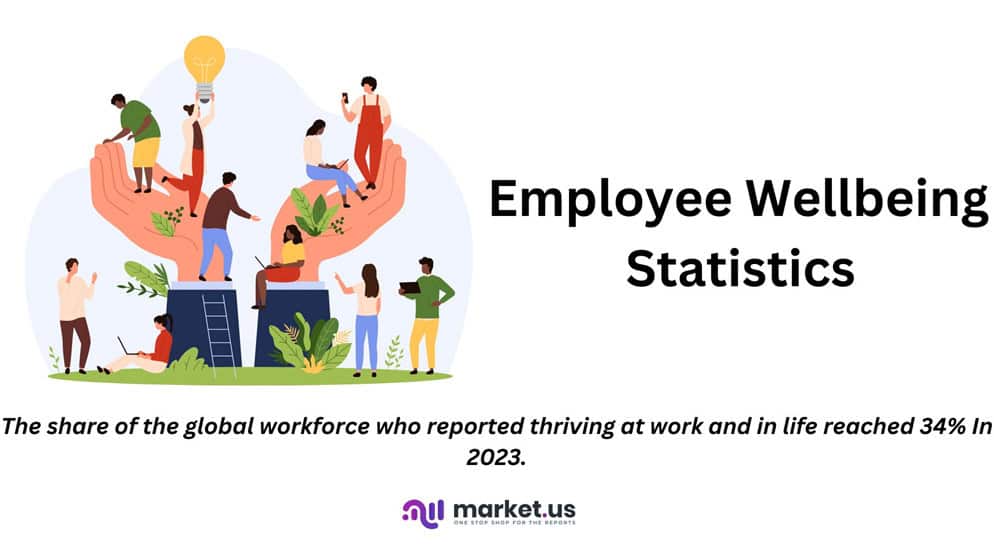
Editor’s Choice
- The global corporate wellness market size is expected to be worth around USD 100.8 Billion by 2032 from USD 56.63 Billion in 2022. Growing at a CAGR of 6.1% during the forecast period from 2022 to 2032.
- The share of the global workforce who reported thriving at work and in life reached 34% In 2023.
- In 2020 and 2021, U.S. employees prioritized various well-being activities in their personal lives with notable consistency and some shifts. Staying within a budget was a top priority, with 83% in 2020 and 81% in 2021.
- In 2023, a survey assessing the sense of well-being among employees from various countries revealed notable differences. Brazil led, with 64% of respondents reporting a sense of well-being from their organization.
- In 2022, the percentage of employees who rated their overall well-being positively varied across select countries worldwide. In the United States, 53% of employees reported a positive sense of well-being, the highest among the surveyed countries.
- In 2023, the sense of success felt by employees from their organizations varied widely across the globe. India topped the list, with 83% of employees feeling a sense of success.
- In 2022, the perceived attractiveness of companies due to their well-being benefits and programs varied across select countries worldwide. Overall, 35% of employees globally stated that such benefits made their company more attractive to potential employees.
- Since the coronavirus outbreak in 2020, a significant percentage of workers have reported various mental health challenges impacting their productivity. Approximately 28.3% of respondents noted difficulty concentrating, while 20% reported that tasks took longer to complete.
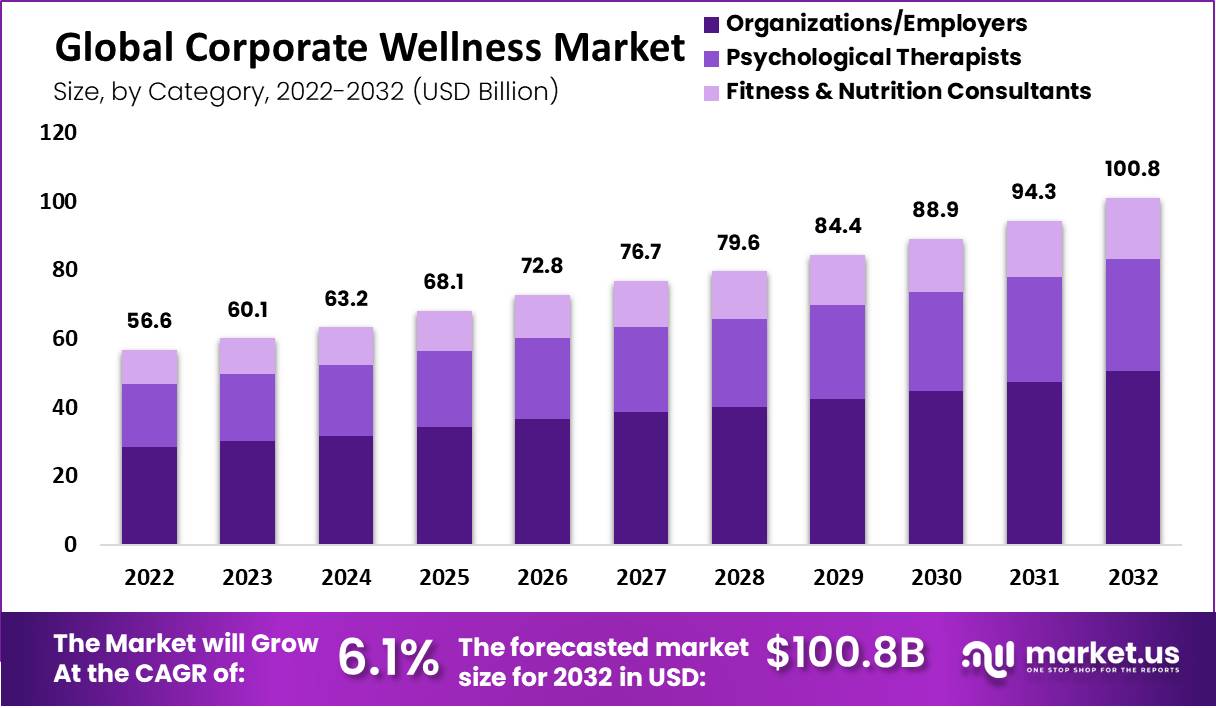
Global Employee Wellbeing Statistics
- From 2009 to 2023, the share of the global workforce who reported thriving at work and in life exhibited significant fluctuations.
- In 2009, 24% of employees felt they were thriving, but this figure sharply dropped to 13% in 2010.
- A slight increase to 14% was noted in 2011.
- By 2012, there was a substantial rise to 31%, which slightly decreased to 30% in 2013.
- This level of thriving was maintained in 2014, followed by another dip to 27% in 2016.
- The proportion declined further to 20% in 2017 before rebounding to 28% in 2018.
- The years 2019 and 2020 saw a return to 30% and an increase to 32%, respectively.
- The upward trend continued with 33% in 2021, peaking at 35% in 2022 before a slight decrease to 34% in 2023.
- Overall, the data reflects an overall positive trajectory in employee well-being over the years despite periodic declines.
(Source: Statista)
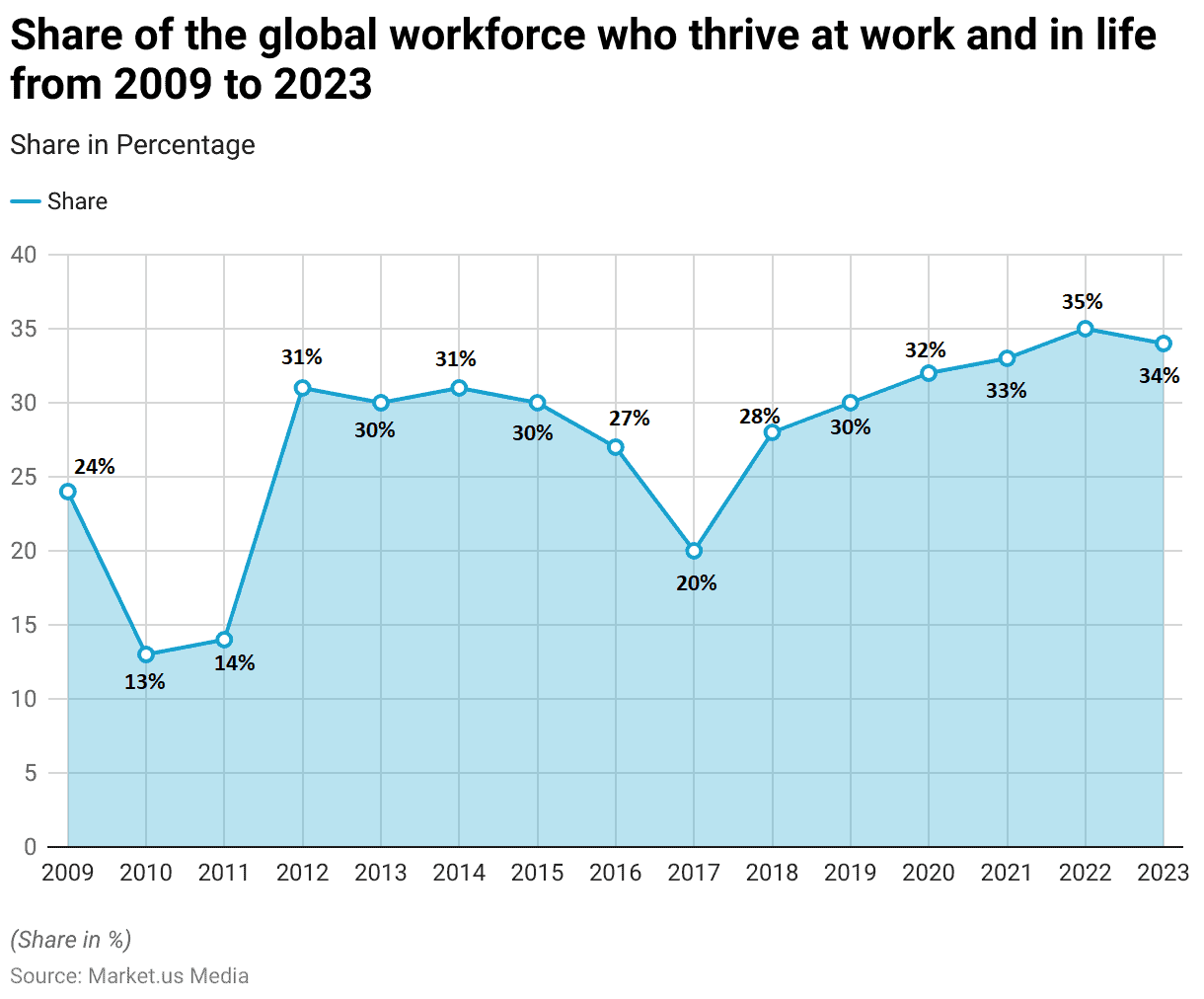
Wellbeing Priorities of Employee Statistics
- In 2020 and 2021, U.S. employees prioritized various well-being activities in their personal lives with notable consistency and some shifts.
- Staying within a budget was a top priority, with 83% in 2020 and 81% in 2021. Eating healthy remained stable at 81% across both years.
- Balancing work and personal commitments saw a slight increase from 77% in 2020 to 79% in 2021.
- Getting enough exercise and managing stress also rose. From 74% to 76% and 73% to 75%, respectively.
- Prioritizing retirement income or wealth accumulation decreased from 79% in 2020 to 74% in 2021.
- Similarly, the importance of growing and maintaining relationships dropped from 75% to 73%.
- Consistently, 72% of employees focused on building an emergency fund in both years.
- The importance of routine medical screenings increased marginally from 70% to 71%. While spending time on personal interests remained constant at 71%.
- Reducing current debt fell from 75% in 2020 to 70% in 2021. Whereas saving for large purchases rose from 53% to 60%.
- Priorities for gaining new job-related skills and advancing careers remained at 60%.
- Caring for dependents saw a decline from 55% to 51%, and finding better housing options slightly increased from 48% to 49%.
- Finally, prioritizing education expenses rose from 36% in 2020 to 40% in 2021.
(Source: Statista)
Take advantage of our unbeatable offer - buy now!

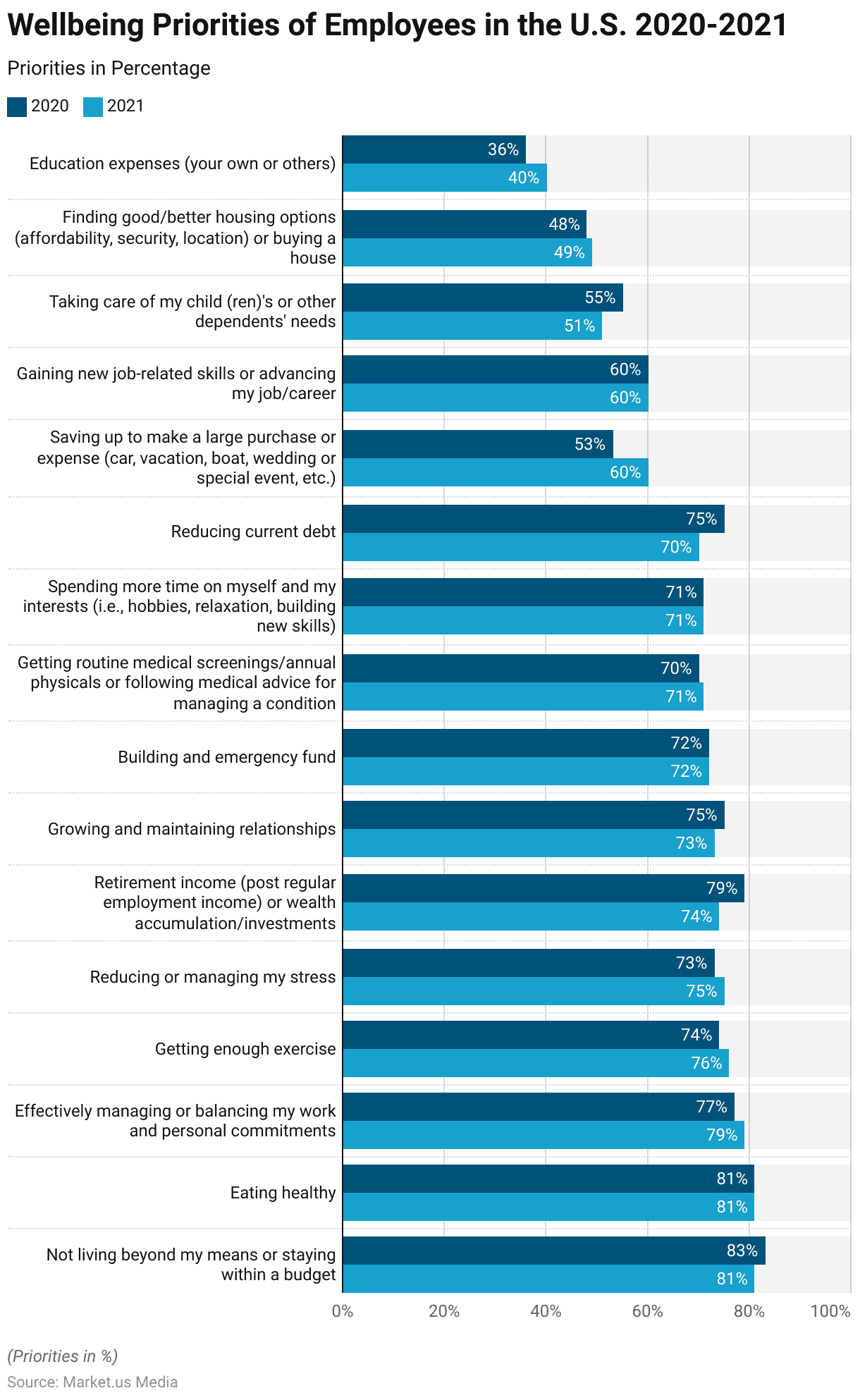
Employee Sense of Wellbeing from Their Organization Worldwide Statistics
- In 2023, a survey assessing the sense of well-being among employees from various countries revealed notable differences.
- Brazil led with 64% of respondents reporting a sense of well-being from their organization. Followed closely by South Africa at 62% and the Philippines at 61%.
- Mexico recorded a 60% satisfaction rate, while Italy followed with 57%.
- The United Kingdom, Canada, Chile, Germany, the United States, and China each reported 56%, indicating a moderate level of employee well-being.
- India and the United Arab Emirates shared a 55% satisfaction rate, paralleled by Argentina.
- In France and Australia, 54% of employees felt a sense of well-being. Whereas South Korea and Japan reported slightly lower figures at 53% and 52%, respectively.
- Saudi Arabia had a 51% satisfaction rate, and Singapore concluded the survey with 50% of respondents feeling a sense of well-being in their organization.
(Source: Statista)
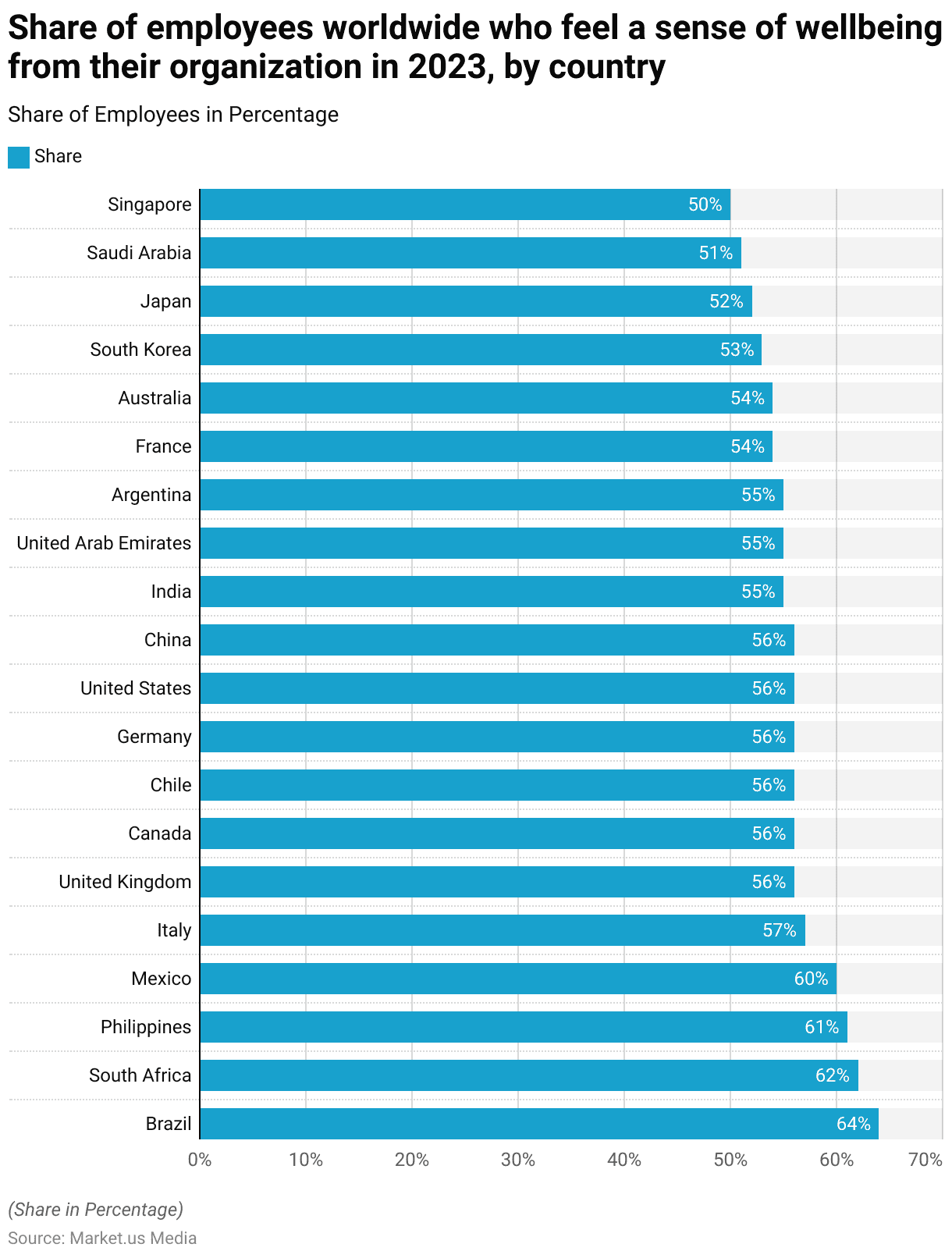
Perception of Organizational Wellbeing Support Among Employee Statistics
- Between May 2019 and February 2023, the percentage of employees in the United States who felt their organization cared about their well-being experienced notable changes.
- In May 2019, only 29% of employees felt cared for by their organization.
- This perception improved significantly by April 2020, reaching 48%.
- However, subsequent months saw a decline, with 41% in June 2020, 42% in August 2020, and 38% in October 2020.
- The trend continued with 37% in December 2020 and 38% in February 2021. Dropping slightly to 36% in March 2021.
- From April to July 2021, the percentage stabilized at 33%, followed by a slight increase to 35% in August 2021.
- In 2022, there was a significant decrease, starting with 24% in February. Falling to 21% in June, and rebounding slightly to 24% in September and 26% in November.
- By February 2023, the percentage stood at 25%, indicating a general decline in employees’ perception of their organization’s care for their well-being over the observed period.
(Source: Statista)
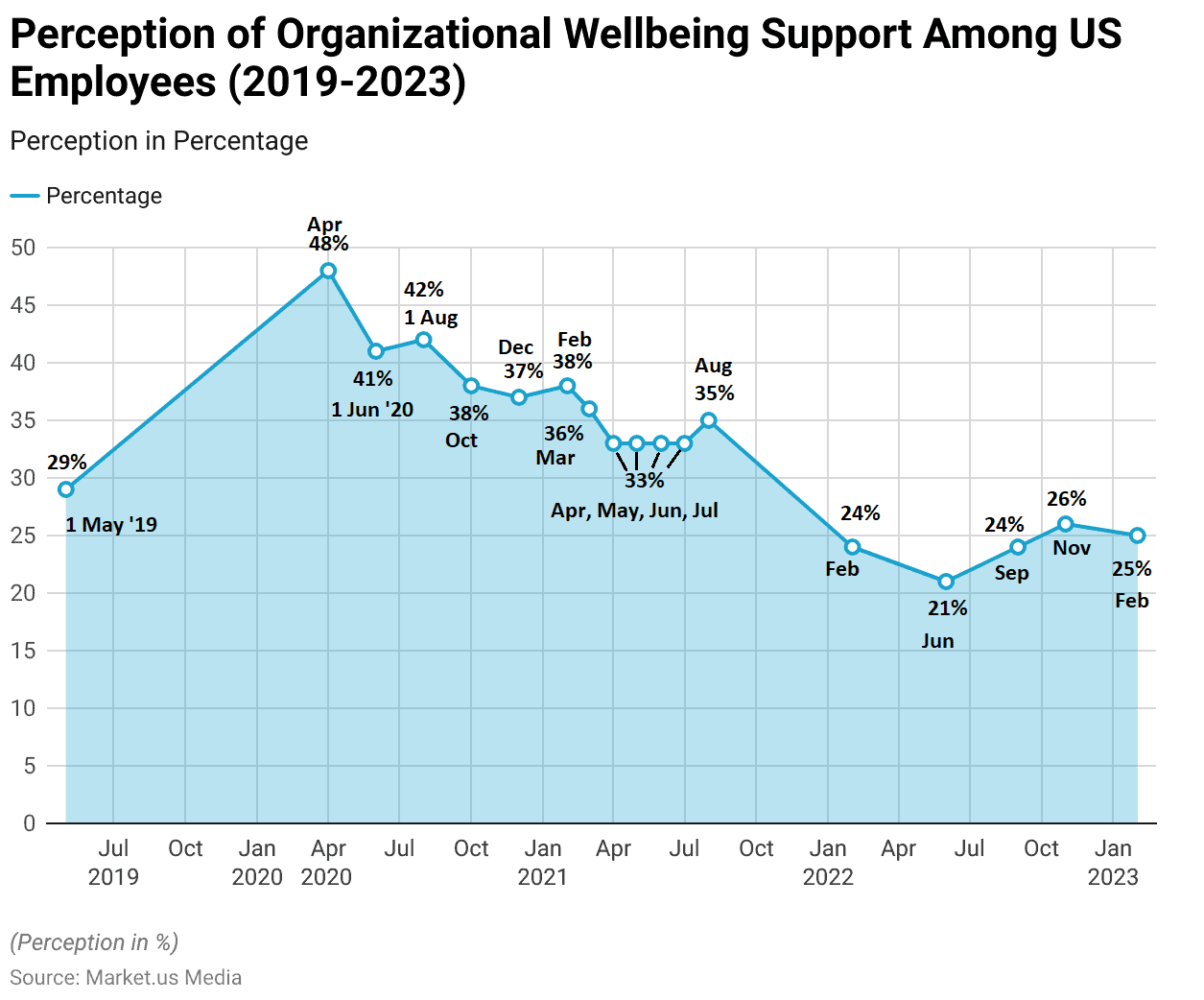
Employee Positive Perceptions of Their Wellbeing Statistics
- Employees’ positive perceptions of their well-being have varied across different aspects from 2018 to 2021.
- In 2021, 40% of employees felt positive about their overall wellbeing. Slightly up from 39% in July 2020, but down from 49% pre-COVID-19 in 2020.
- Mental and emotional well-being was rated positively by 39% in 2021. Compared to 37% in July 2020 and 46% pre-COVID-19 in 2020.
- This was a decline from 43% in 2019 and 49% in 2018.
- Social wellbeing saw a similar trend, with 38% positivity in 2021. Increasing from 33% in July 2020 but decreasing from 45% pre-COVID-19 in 2020, 34% in 2019, and 35% in 2018.
- Physical wellbeing was positively perceived by 39% in 2021, up from 38% in July 2020, yet down from 44% pre-COVID-19 in 2020, 42% in 2019, and 43% in 2018.
- Professional and career well-being received a 36% positive rating in 2021. This compared to 34% in July 2020 and 44% pre-COVID-19 in 2020, which was a decline from 39% in 2019 and 40% in 2018.
- Financial well-being was rated positively by 35% in both 2021 and July 2020. Down from 40% pre-COVID-19 in 2020 but similar to 34% in 2019 and 35% in 2018.
- These figures highlight a general decline in positive perceptions of well-being among employees across various dimensions over the observed period.
(Source: Employee Wellbeing Mindset Study – 2021)
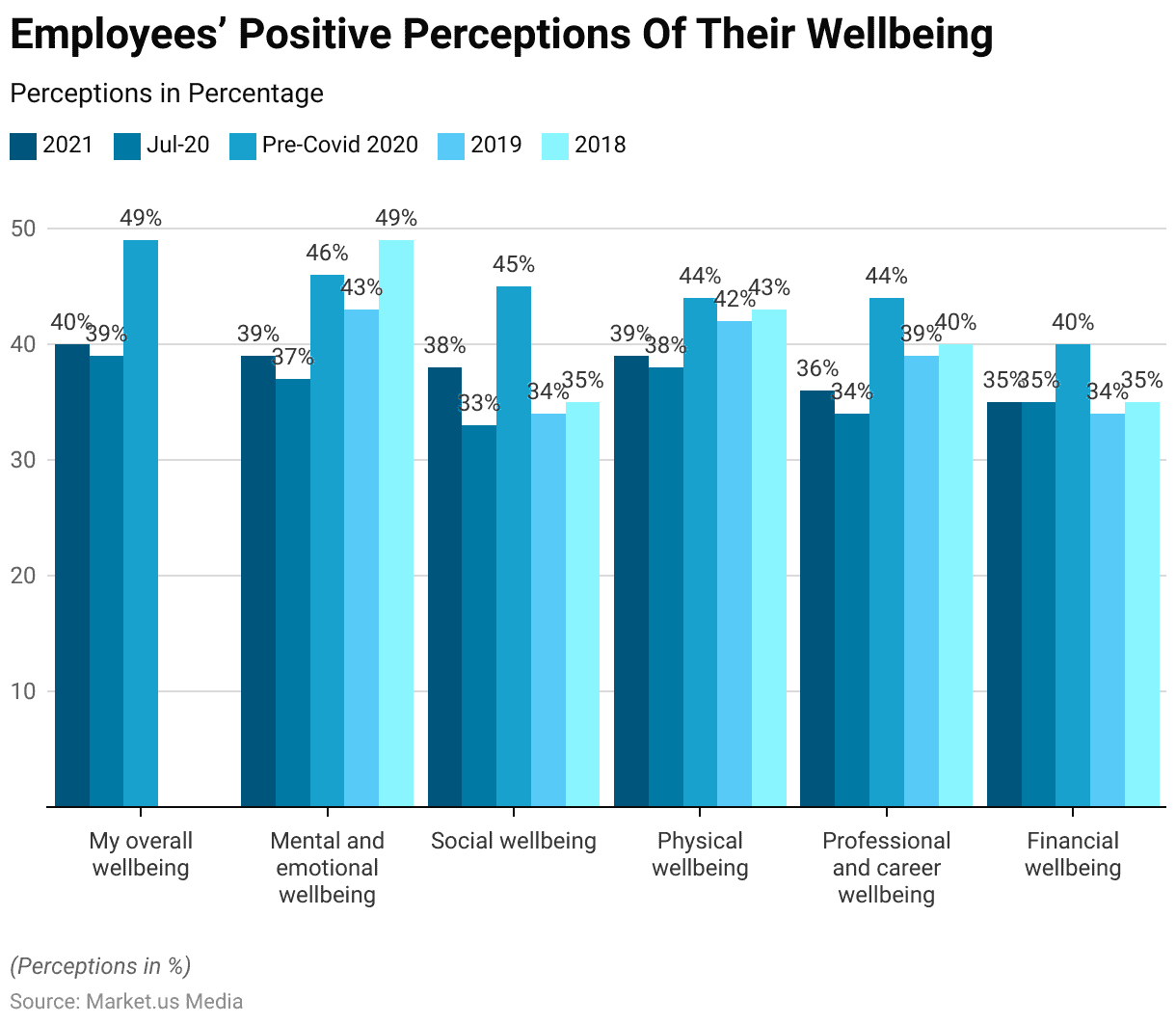
Perception of Employee on Physical and Mental Wellbeing Statistics
- As of 2022, the perception of U.S. employees regarding their employer’s concern for their overall mental health and physical well-being varied significantly.
- 6% of employees felt that their employer did not care about their well-being at all, while 10% believed their employer cared very little.
- A larger portion, 27%, felt that their employer somewhat cared about their well-being.
- Additionally, 32% of employees perceived that their employer cared a moderate amount, and 25% felt that their employer cared a great deal about their overall mental health and physical well-being.
- This data indicates a diverse range of perceptions among employees concerning their employer’s commitment to their well-being.
(Source: Statista)

Impact of Jobs On Mental Health According to Employee Wellbeing Statistics
- As of 2022, U.S. employees reported varying impacts of their jobs on their mental health.
- 7% of employees described the impact as extremely positive, while 23% indicated a somewhat positive effect.
- 30% of employees felt that their job had no impact on their mental health.
- Conversely, 33% reported a somewhat negative impact, and 7% described the impact as extremely negative.
- This data reflects a broad spectrum of experiences, with a significant portion of employees perceiving their jobs as having a negative influence on their mental health.
(Source: Statista)

Positive Perceptions of Employee Wellbeing Statistics
Employees Globally Who Rate Their Overall Wellbeing Positively Statistics
- In 2022, the percentage of employees who rated their overall well-being positively varied across select countries worldwide.
- In the United States, 53% of employees reported a positive sense of well-being, the highest among the surveyed countries.
- The Netherlands followed with 46%, while Germany had 44% of employees feeling positively about their wellbeing.
- In the United Kingdom, 40% of employees rated their wellbeing positively.
- France had the lowest percentage, with only 35% of employees expressing a positive perception of their overall well-being.
- This data highlights significant differences in employee well-being perceptions across these countries.
(Source: Statista)
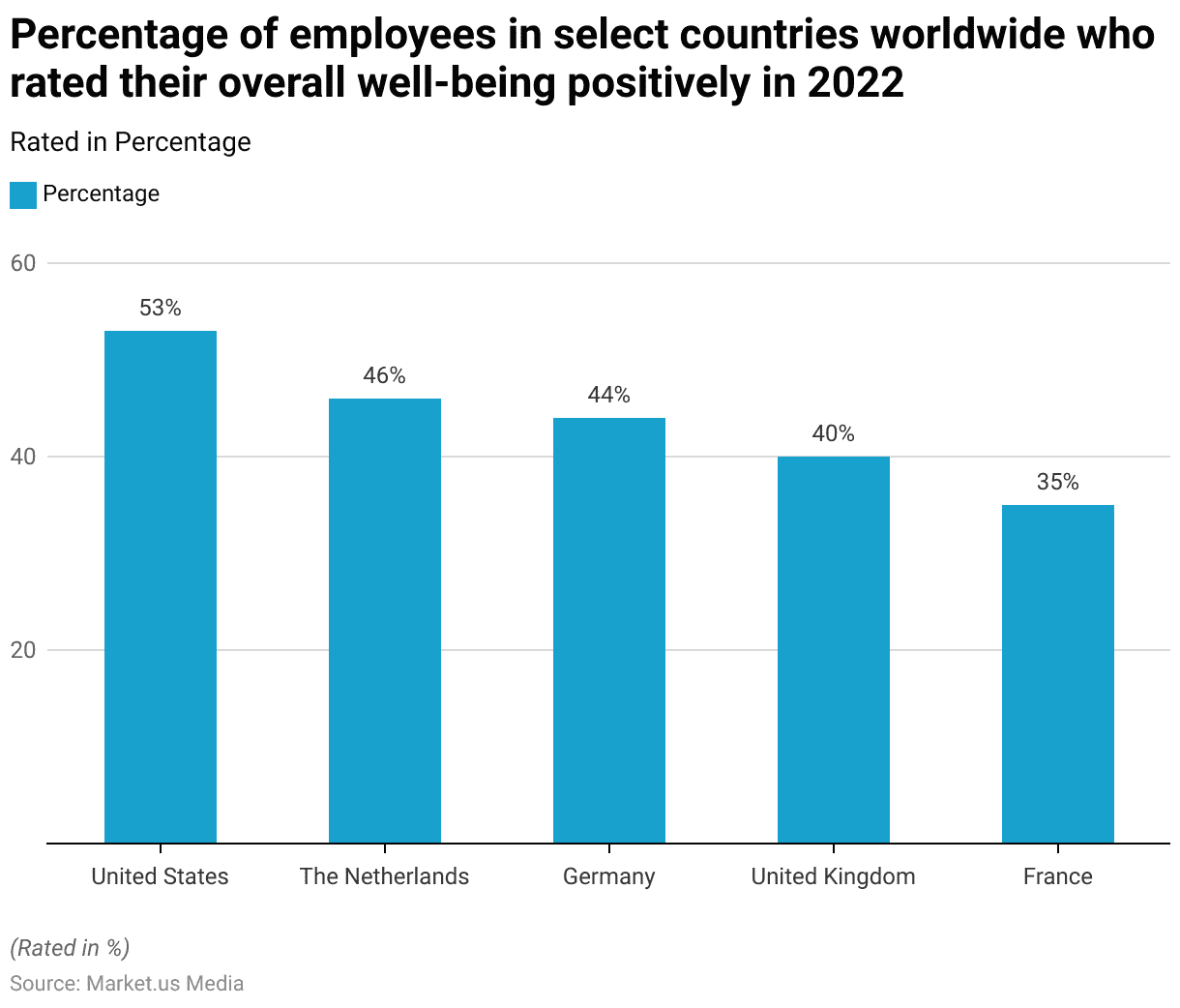
Satisfaction of Employee Wellbeing with Their Financial Situation Statistics
- In 2018, the satisfaction of employees in the United States with their financial situation showed a range of opinions.
- 15% of respondents reported being very satisfied with their financial situation, while 47% were somewhat satisfied.
- On the less positive side, 28% of employees felt somewhat dissatisfied, and 9% were very dissatisfied with their financial situation.
- Additionally, 1% of respondents indicated they did not know or had no opinion on the matter.
- This data reflects a diverse set of financial satisfaction levels among U.S. employees during that year.
(Source: Statista)
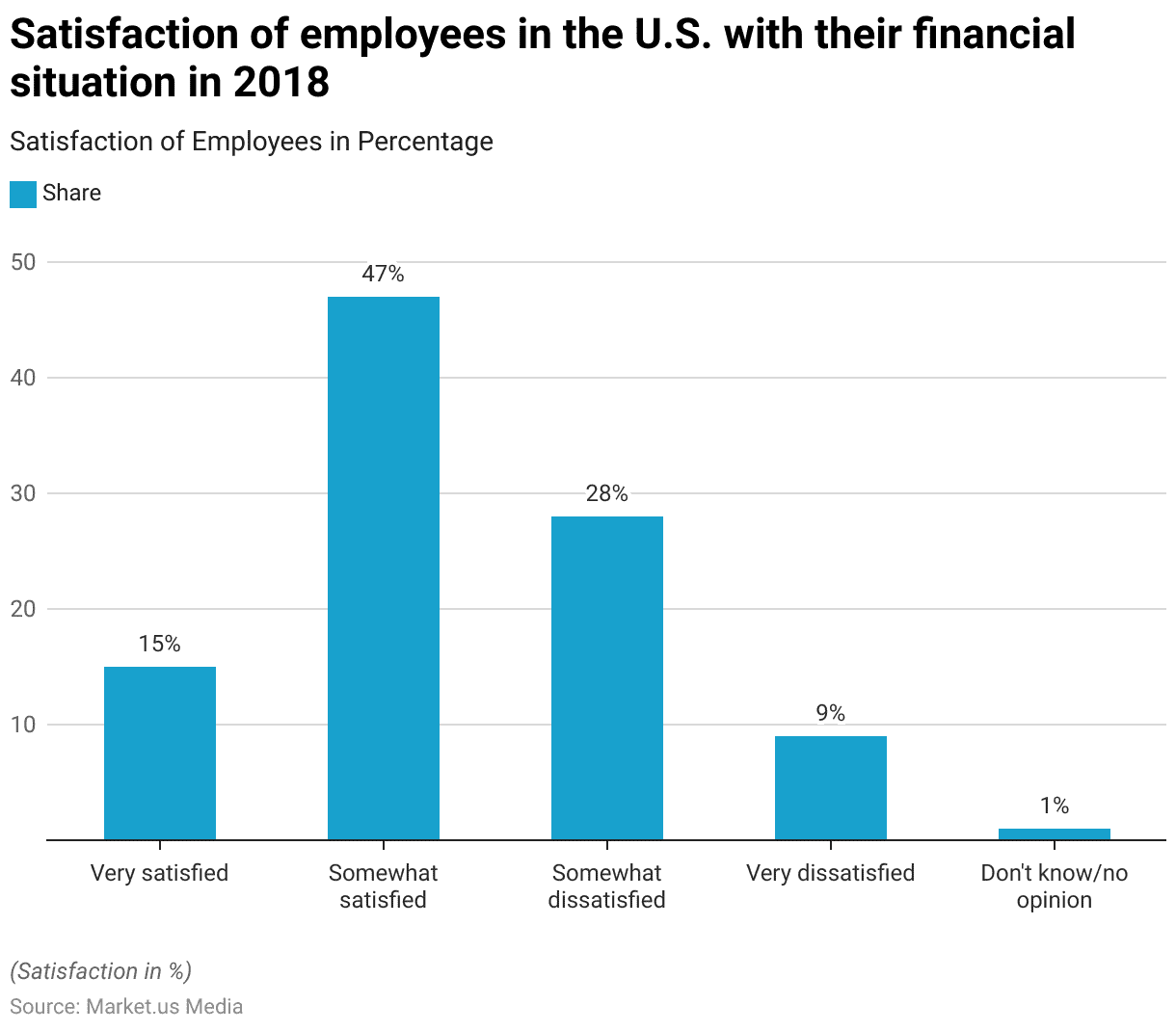
Employees’ Sense of Appreciation at Their Organization
- In 2023, the sense of appreciation felt by employees at their organizations varied globally.
- Brazil led with 70% of respondents feeling appreciated, followed closely by the Philippines, China, and India, each at 69%.
- In South Africa, 68% of employees reported a sense of appreciation. While in the United States, this figure was 66%.
- The United Arab Emirates and Saudi Arabia both had 65%.
- Canada and Mexico each reported 61%, and South Korea had 60%.
- In Singapore, Australia, and Chile, 59% of employees felt appreciated. While in Germany and the United Kingdom, the figure was 58%.
- France and Italy followed with 57% and 56%, respectively.
- Argentina had 55%, and Japan had the lowest sense of appreciation among employees, at 52%.
- This data underscores the varying levels of employee appreciation across different countries.
(Source: Statista)
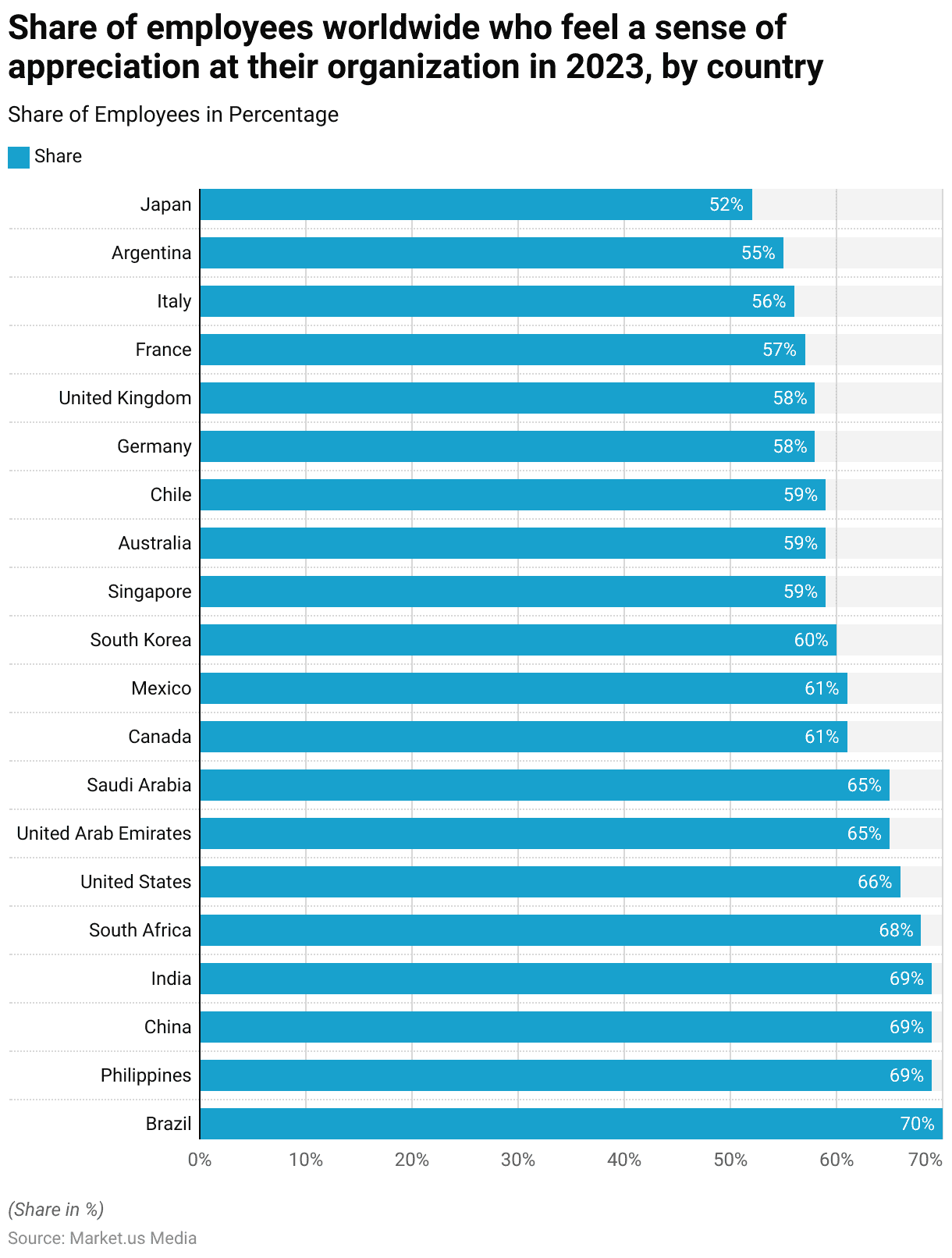
Employees’ Sense of Success from Their Organization Worldwide
- In 2023, the sense of success felt by employees from their organizations varied widely across the globe.
- India topped the list, with 83% of employees feeling a sense of success.
- The Philippines, China, Brazil, and the United States each had 77% of respondents reporting a sense of success.
- In Saudi Arabia, this figure was 76%, followed by the United Arab Emirates at 75% and South Africa at 74%.
- Mexico reported 71%, while Canada and Singapore each had 67%.
- In Chile and Australia, 65% of employees felt successful, and in the United Kingdom, the figure was 64%.
- Germany reported 62%, followed closely by Italy at 61% and France and Argentina at 60% each.
- South Korea had 58% of employees feeling successful, and Japan had the lowest percentage. With only 49% of employees feeling a sense of success in their organization.
- This data highlights the varying perceptions of success among employees in different countries.
(Source: Statista)
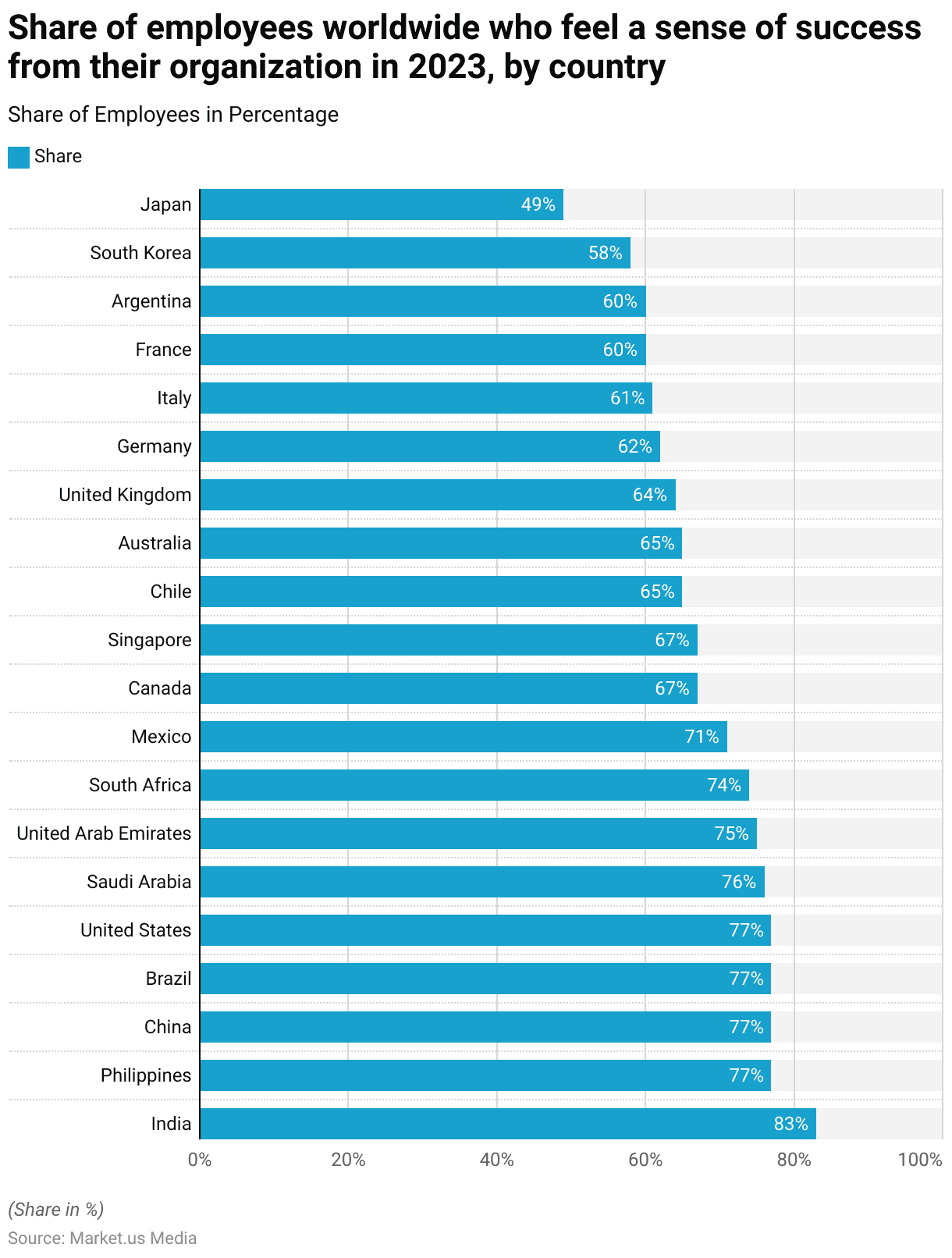
Job Satisfaction Rates of Employees – By Education Level
- Between 1972 and 2012, job satisfaction rates among U.S. employees aged 30 to 45 varied by education level.
- Among those with less than a high school diploma, 40% reported being moderately satisfied, while 42% were very satisfied.
- Employees with a high school diploma showed slightly higher satisfaction, with 41% moderately satisfied and 47% very satisfied.
- For those with some college or an associate degree, 39% were moderately satisfied, and 48% were very satisfied.
- The highest satisfaction rates were observed among employees with a bachelor’s degree or higher, with 38% moderately satisfied and 51% very satisfied.
- This data indicates that higher educational attainment is associated with increased job satisfaction among this age group in the United States.
(Source: Statista)
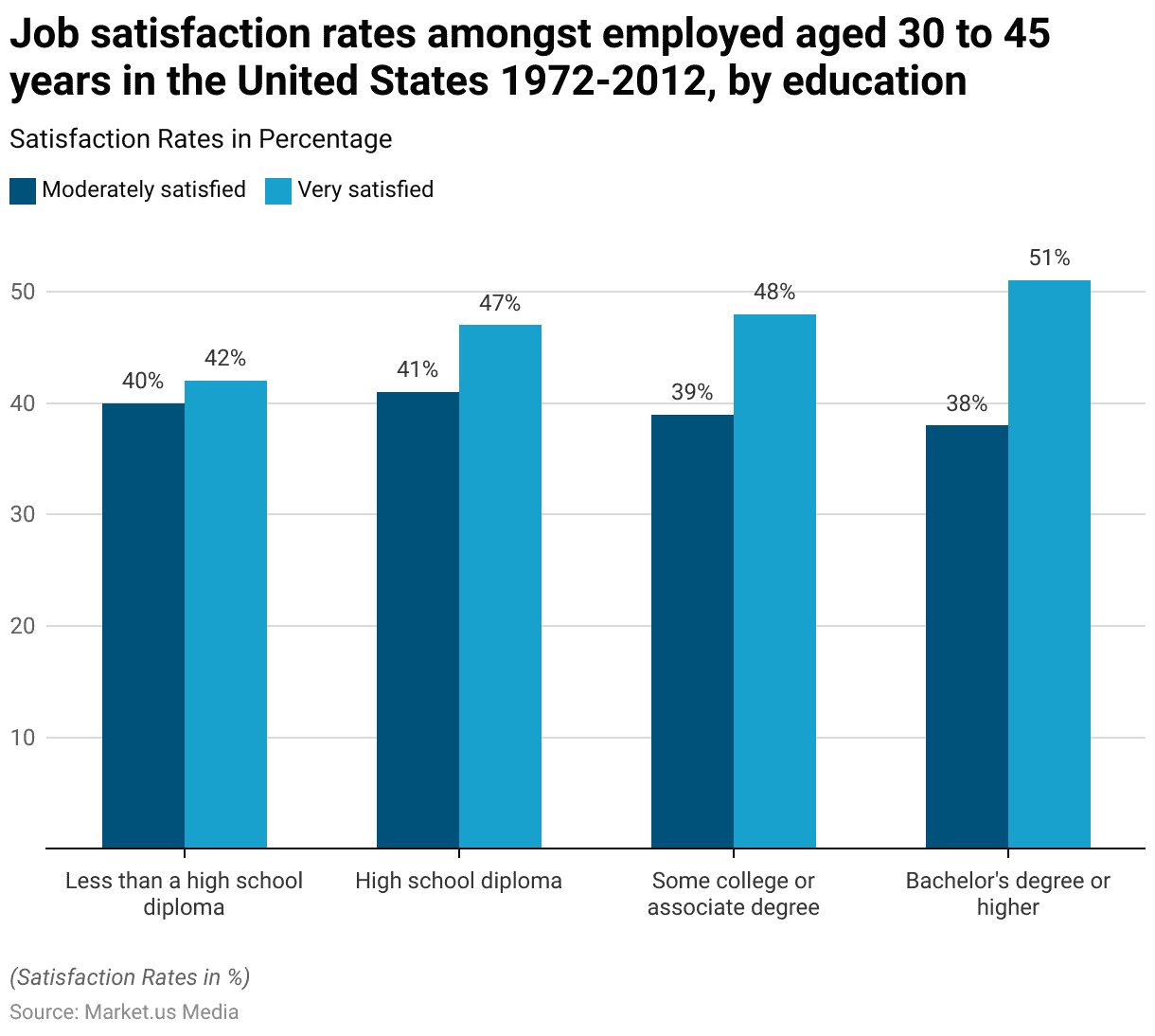
Attitudes About Work Among Employees
- In 2020 and 2021, the attitudes of U.S. employees towards work revealed significant insights into their digital workplace experiences.
- The percentage of employees who often dreaded going to work or starting their workday increased from 23% in 2020 to 29% in 2021.
- The ability to be oneself at work saw a slight decline, with 56% of employees feeling this way in 2020, compared to 55% in 2021.
- Additionally, the proportion of employees who felt they could effectively balance and manage their work and personal life commitments decreased from 65% in 2020 to 60% in 2021.
- These changes indicate growing challenges in job satisfaction and work-life balance among U.S. employees during this period.
(Source: Statista)
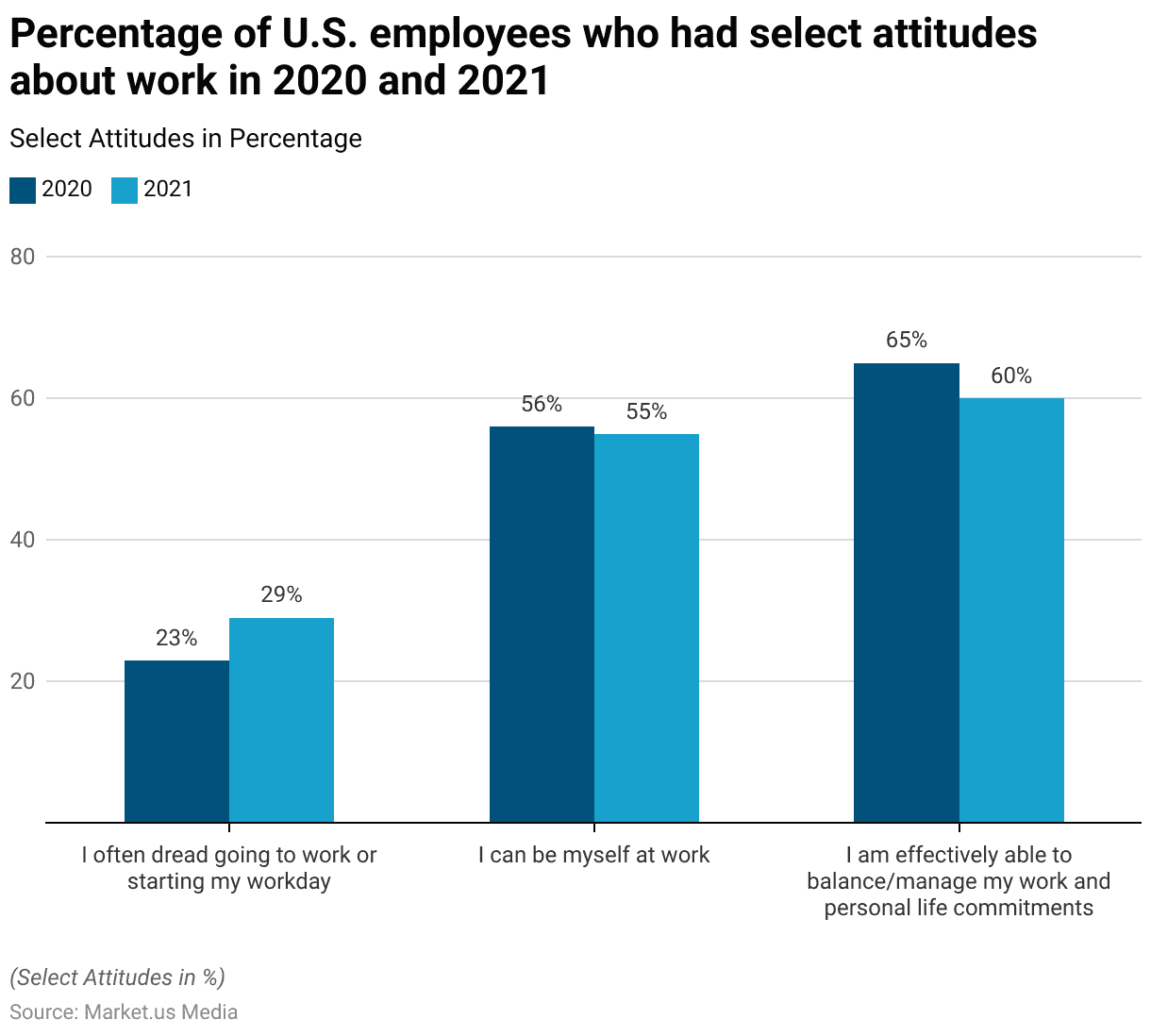
Impact of Company Culture and Environment On Employee Wellbeing Statistics
- In 2021, the impact of company culture and environment on overall well-being varied across different age groups.
- Globally, 18% of employees felt that their company culture contributed very positively to their well-being, while 32% felt it was somewhat positive.
- However, 33% reported no real impact, 12% felt it somewhat negatively impacted their wellbeing, and 5% felt it very negatively impacted them.
- Among Gen Z employees, 14% reported a very positive impact, 35% somewhat positive, 35% no real impact, 14% somewhat negative, and 2% very negative.
- Emerging millennials had a more positive outlook, with 19% feeling very positive and 35% somewhat positive. While 31% saw no real impact, 12% felt somewhat negative, and 4% very negative.
- Established millennials reported the highest very positive impact at 24%. With 31% somewhat positive, 31% no real impact, 10% somewhat negative, and 4% very negative.
- Gen X employees mirrored the global average closely, with 18% very positive, 30% somewhat positive, 34% no real impact, 14% somewhat negative, and 5% very negative.
- Boomers reported the lowest very positive impact at 14%, with 29% somewhat positive, 37% no real impact, 14% somewhat negative, and 7% very negative.
- These findings highlight generational differences in perceptions of how company culture and environment affect overall well-being.
(Source: Employee Wellbeing Mindset Study – 2021)
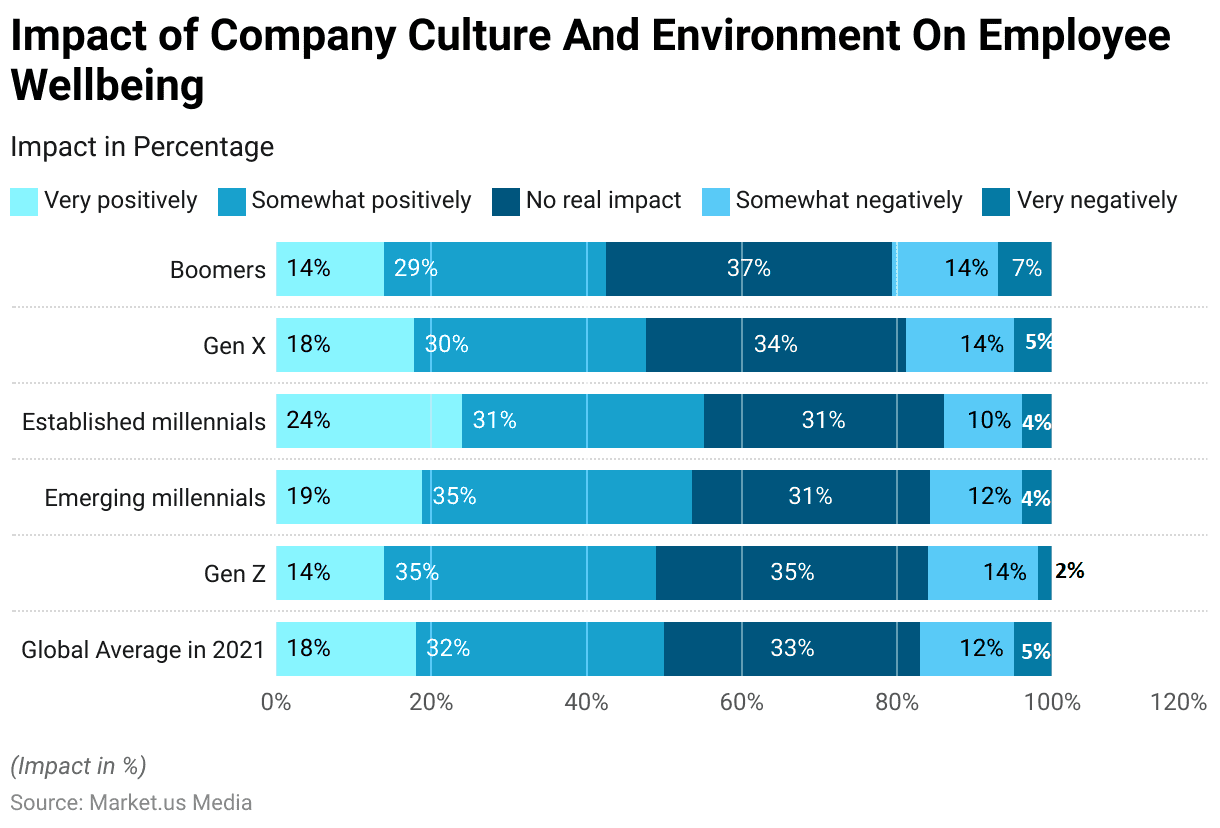
Employee Wellbeing Initiatives Statistics
Employees Opinions About Employer Wellbeing Programs
- From 2019 to 2021, U.S. employees increasingly appreciated the well-being programs offered by their employers, with positive sentiments growing each year.
- In 2019, 81% of employees found these programs easy to access when needed. A figure that rose to 84% in 2020 and 85% in 2021.
- The percentage of employees who felt these programs made them feel better about their employer increased from 78% in 2019 to 80% in 2020 and further to 84% in 2021.
- The perception of these programs as a good business investment also grew, from 80% in 2019 to 81% in 2020 and 84% in 2021.
- Employees also increasingly believed that well-being programs made their company more attractive to potential employees. With agreement rising from 78% in 2019 to 81% in 2020 and 83% in 2021.
- The programs were seen as enhancing overall engagement experiences. With 77% agreeing in 2019, 81% in 2020, and 83% in 2021.
- Furthermore, 75% of employees in 2019 felt the programs were effective in helping them create a better financial future, which increased to 79% in 2020 and 82% in 2021.
- The belief that these programs helped employees avoid getting sick grew significantly from 68% in 2019 to 70% in 2020 and 79% in 2021.
- Lastly, the percentage of employees who cited these programs as one of the reasons for staying at their jobs increased from 70% in 2019 to 74% in 2020 and 75% in 2021.
(Source: Statista)

Employees Who Say That Wellbeing Benefits Make a Company Attractive
- In 2022, the perceived attractiveness of companies due to their well-being benefits and programs varied across select countries worldwide.
- Overall, 35% of employees globally stated that such benefits made their company more attractive to potential employees.
- This perception was notably higher in the United States, where 50% of employees agreed.
- In the United Kingdom, 36% of employees felt the same. Closely followed by Germany at 34% and the Netherlands at 33%.
- France had the lowest percentage, with only 24% of employees indicating that well-being benefits and programs enhanced their company’s attractiveness to potential hires.
- These figures highlight the varying degrees of importance placed on wellbeing programs in different countries.
(Source: Statista)

Employer Opinion On Positive Impacts of Company Wellness Programs
- From 2015 to 2019, U.S. employers consistently reported positive impacts of their company’s wellness programs across various metrics.
- In 2015 and 2016, 82% of employers observed improvements in workers’ health, and 80% noted enhanced productivity and performance. With healthcare costs being positively impacted by 71% and 72% of employers, respectively.
- In 2017, there was a slight dip, with 78% reporting better worker’s health, 75% observing increased productivity and performance, and 69% seeing reductions in healthcare costs.
- However, in 2018, these figures rose again, with 79% acknowledging improvements in worker’s health, 77% in productivity and performance, and 71% in healthcare costs.
- By 2019, the positive impacts were more pronounced, with 83% of employers reporting better worker health, 84% noting enhanced productivity and performance, and 72% recognizing reductions in healthcare costs.
- This data indicates a generally positive and growing perception of the benefits of wellness programs among U.S. employers over this period.
(Source: Statista)
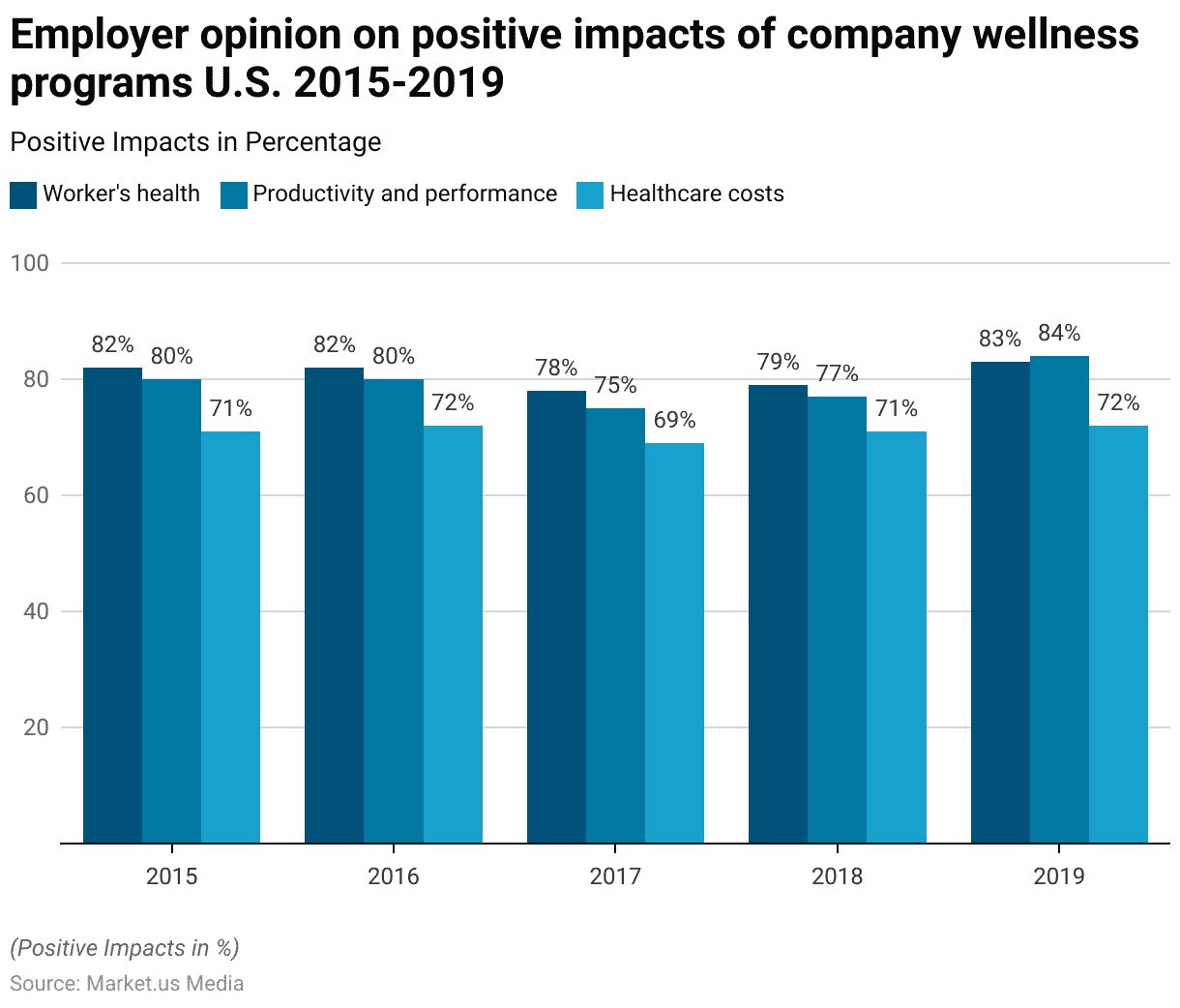
Impact of COVID-19
By Organizations
- The pandemic has significantly influenced how organizations prioritize various business initiatives.
- According to respondents, 62% indicated an increased focus on enhancing operational efficiency.
- Transforming existing business processes became a priority for 56% of organizations while improving customer experience and increasing cybersecurity protections were each emphasized by 55% of respondents.
- Optimizing the employee digital experience was a priority for 48%, and 47% aimed to improve employee productivity.
- Improving profitability was a focus for 40% of organizations, and 38% prioritized both introducing new digital revenue streams and enabling new product development.
- Increasing topline revenue was important for 31% while improving talent acquisition and retention was a priority for 19%.
- Lastly, 15% of respondents focused on monetizing company data, and 12% aimed to meet compliance requirements such as GDPR.
- These priorities highlight a shift towards digital transformation, efficiency, and employee and customer-centric strategies in response to the pandemic.
(Source: Statista)

COVID-19 Pandemic Impact On Mental Health of Employees – By Generation
- In 2021, the impact of the COVID-19 pandemic on mental health varied significantly across different generations of U.S. employees.
- Overall, 22% of employees reported that their mental health had significantly or somewhat improved during the pandemic, while 40% felt there was no real change.
- However, 40% indicated that their mental health had significantly or somewhat declined due to the pandemic.
- Among Gen Z employees, 28% experienced an improvement in mental health, contrasting with 46% who reported a decline.
- For emerging millennials, 31% saw improvement, while 41% experienced a decline.
- Established millennials had the highest percentage reporting improvement at 32%, with 37% noting a decline.
- Gen X employees had the lowest improvement rate at 14%, with an equal 41% reporting a decline.
- Among boomers, only 4% saw an improvement, while 35% experienced a decline in mental health during the pandemic, with the majority (60%) reporting no real change.
- These findings underscore the varied and sometimes profound effects of the pandemic on mental health across different age groups in the U.S. workforce.
(Source: Statista)

Workers’ Mental Challenges to Productivity Since COVID-19 Outbreak
- Since the coronavirus outbreak in 2020, a significant percentage of workers have reported various mental health challenges impacting their productivity.
- Approximately 28.3% of respondents noted difficulty concentrating, while 20% reported that tasks took longer to complete.
- About 14.7% struggled with thinking, reasoning, or decision-making, and 12.4% admitted to procrastinating on challenging work.
- Additionally, 11.8% of workers found it difficult to manage multiple tasks or responsibilities effectively.
- These findings highlight the pervasive impact of mental health issues on workplace productivity following the onset of the pandemic.
(Source: Statista)
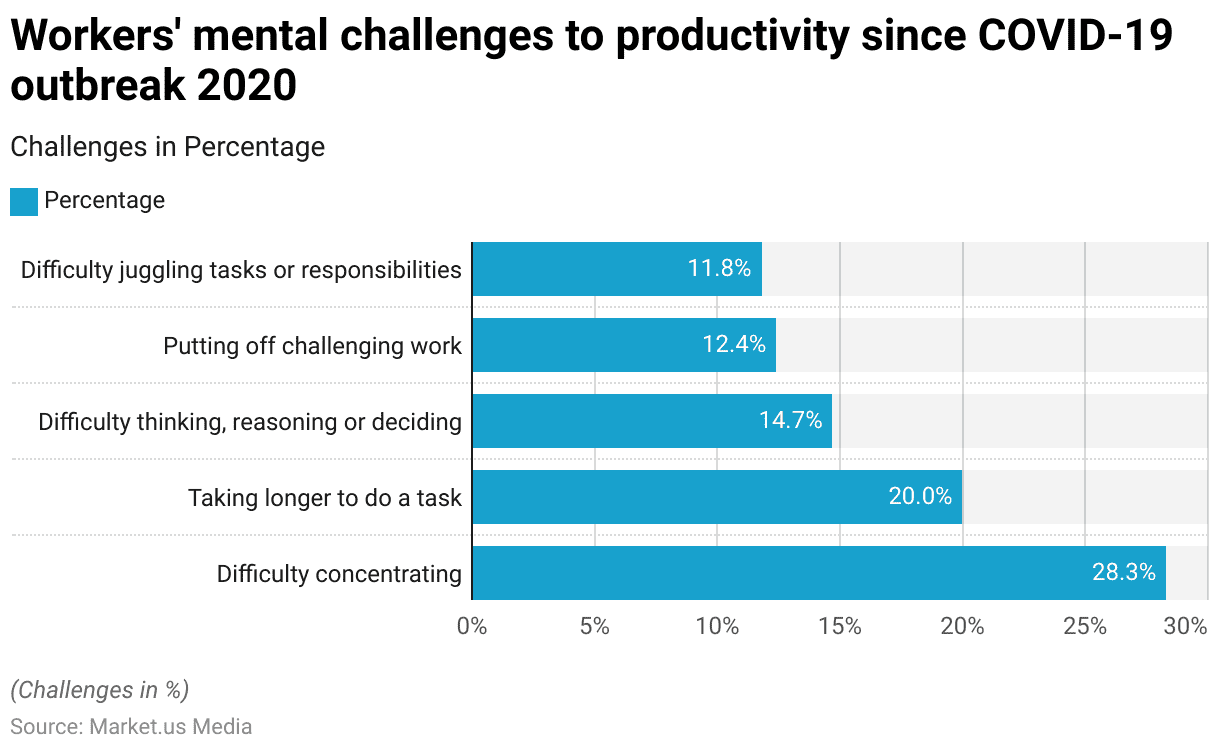
Suggestions and Solutions to Support Employee Wellbeing Statistics
- In uncertain times, seeking input from employees about the support they desire is crucial. Research by the American Psychological Association (APA) revealed that among 12 possible supports, the most favored were flexible work hours, preferred by 41% of respondents.
- Additionally, 34% valued a workplace environment that honors time off, while 33% sought remote work options.
- Another popular choice was a four-day workweek, which appealed to 31% of those surveyed.
- These preferences underscore the importance of accommodating flexibility and work-life balance in employee support strategies.
(Source: American Psychological Association (APA))
Recent Developments
Acquisitions and Mergers:
- Limeade acquires TINYpulse: In mid-2023, Limeade, an employee experience software company, acquired TINYpulse, a provider of employee engagement and feedback solutions, for $45 million. This acquisition aims to enhance Limeade’s ability to offer comprehensive employee well-being and engagement solutions.
- Virgin Pulse acquires Welltok: In late 2023, Virgin Pulse, a leader in digital health and wellbeing solutions, acquired Welltok for $200 million. Welltok’s data-driven health optimization platform is expected to strengthen Virgin Pulse’s offerings in employee health and wellbeing.
New Product Launches:
- Microsoft Viva Insights: In early 2024, Microsoft launched Viva Insights, a part of its Viva employee experience platform. Viva Insights uses data analytics to provide actionable insights into employee wellbeing, helping organizations improve work-life balance and productivity.
- Headspace for Work: Headspace introduced a new version of its mindfulness and meditation app tailored for corporate use, called Headspace for Work, in mid-2023. This platform includes guided meditation sessions, stress management tools, and resources to support mental health in the workplace.
Funding:
- BetterUp raises $300 million: In 2023, BetterUp, a platform for coaching and mental health support, secured $300 million in a Series E funding round. This funding will be used to expand its services and develop new tools for employee mental health and development.
- Modern Health secures $200 million: Modern Health, a mental health and wellness platform, raised $200 million in early 2024 to enhance its offerings and expand its global reach. The platform provides therapy, coaching, and digital programs to support employee mental health.
Technological Advancements:
- AI and Machine Learning for Wellbeing: Advances in AI and machine learning are being used to personalize employee wellbeing programs, providing tailored recommendations and insights based on individual needs and behaviors.
- Wearable Technology Integration: Wearable devices are increasingly being integrated into employee wellbeing programs to monitor physical activity, sleep patterns, and stress levels, providing real-time data to support healthier lifestyles.
Market Dynamics:
- Growth in Employee Wellbeing Market: The global employee wellbeing market is projected to grow at a CAGR of 9.8% from 2023 to 2028, driven by increasing awareness of mental health, the importance of work-life balance, and the adoption of digital wellbeing solutions.
- Increased Corporate Investment: Companies are investing more in employee well-being programs to improve job satisfaction, reduce turnover, and enhance overall productivity. This trend is particularly strong in industries with high levels of stress and burnout.
Regulatory and Strategic Developments:
- Mental Health Parity and Addiction Equity Act (MHPAEA): In the US, regulatory frameworks like the MHPAEA are being strengthened to ensure that employee mental health benefits are on par with physical health benefits, promoting comprehensive well-being.
- EU Workplace Wellbeing Policies: The European Union is promoting workplace wellbeing policies, encouraging member states to implement programs that support mental health, work-life balance, and employee engagement.
Research and Development:
- Impact of Remote Work on Wellbeing: R&D efforts are focusing on understanding the impact of remote and hybrid workplace work models on employee well-being, and exploring strategies to support mental health and productivity in flexible work environments.
- Mindfulness and Resilience Training: Researchers are developing and testing new mindfulness and resilience training programs to help employees manage stress, improve focus, and enhance overall well-being.
Conclusion
Employee Wellbeing Statistics – Employee well-being is not merely a buzzword but a critical factor influencing organizational success.
By prioritizing the holistic health and happiness of employees, organizations can foster a productive, engaged, and resilient Workforce Management.
From promoting work-life balance and offering comprehensive wellness programs to cultivating a supportive and inclusive workplace culture, investing in employee wellbeing yields tangible benefits.
These include improved job satisfaction, reduced turnover, enhanced productivity, and a stronger employer brand.
As businesses navigate dynamic challenges and opportunities, nurturing employee well-being remains an essential strategy for building a sustainable and thriving workplace environment.
FAQs
Employee well-being refers to the holistic health and happiness of employees in the workplace. It encompasses physical, mental, emotional, and social aspects of health that contribute to overall job satisfaction and productivity.
Employee well-being is crucial because it directly impacts productivity, job satisfaction, employee engagement, and retention. Organizations that prioritize employee well-being often experience higher morale, lower absenteeism, and increased loyalty among their workforce.
Factors influencing employee well-being include work-life balance, job security, workplace culture, relationships with colleagues and supervisors, physical work environment, access to healthcare and wellness programs, and opportunities for personal and professional development.
Employers can promote employee wellbeing by offering wellness programs flexible work arrangements, promoting work-life balance, providing access to mental health resources, creating a supportive and inclusive workplace culture, offering competitive benefits, and encouraging open communication and feedback.
Signs that employees may be struggling with their well-being include decreased productivity, increased absenteeism, mood swings, changes in behavior or attitude, decreased engagement, and physical symptoms like fatigue or headaches.
Discuss your needs with our analyst
Please share your requirements with more details so our analyst can check if they can solve your problem(s)



